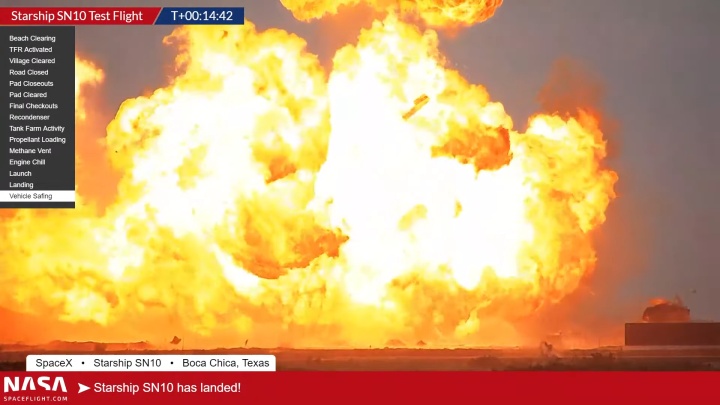Starship SN10 Lands Succesfully and Explodes
Elon Musk's Starship space program reports progress. The prototype spacecraft, designated SN10, did not explode on landing... it did so a few minutes afterwards.

- Starship completed a fully successful flight, this time landing as planned;
- Instead, the explosion occurred a few minutes after the landing.
'That's one small step for man, one giant leap for mankind,' said Neil Armstrong on July 20, 1969, after successfully landing on the moon. Can they be used again, commenting on the test flight of the prototype Starship SN10? Theoretically, because this unit finally landed without issues. Unlike its predecessors, it did not hit the ground, but desceneded rather smoothly on the landing pad at Boca Chica, Texas. Standing somewhat crookedly but in one piece, Starship SN10 could be admired for a few minutes, after which it decided to explode.
Armstrong's quote might have meant something, at least to the "mankind" who were passengers on the ship. The explosion was delayed securing a few minutes to allow for possible evacuation. Interestingly, the official SpaceX broadcast (an abbreviated recording) ended shortly after the landing, so it doesn't show the explosion. NASA Spaceflight's transmission lasted longer and captured the moment.

Internet memes related to the flight of the prototype also quickly began to appear.

It is unclear what could have caused the explosion. In this video, we can see that one of the legs did not lock into the landing position. Hence perhaps the tilt of the spacecraft after touchdown. Flames could be seen on the landing pad, which could indicate a fuel leak and a fire. It is possible that both facts were related to each other. Here is the content of SpaceX's official announcement:
"SN10 experienced a rapid, unscheduled disassembly shortly after landing."
The flight of the prototype was to test computer-programmed maneuvers in the air, as well as land using the engines. The entire spacecraft will also include the Super Heavy launch module. The Starship is designed as a versatile means of transportation, capable of taking 100 tons of cargo to Earth's orbit, Mars or the Moon. In the future, it may also serve as a space shuttle to the planned Voyager space station.
- Baldur's Gate 3 publisher criticizes Elon Musk's plans. „We don't need another cash grab”
- Do you need to play The Outer Worlds 1 before The Outer Worlds 2? Here's how the connections between RPGs look like
- “It’s better than Wikipedia,” Elon Musk announces Grokipedia 0.1 release, but people are already spotting flaws
0

Author: Arkadiusz Strzala
His adventure in writing began with his own blog and contributing to one of the early forums (in the olden days of Wireless Application Protocol). An electrical engineer by profession, he has a passion for technology, constructing and, of course, playing computer games. He has been a newsman and writer for Gamepressure since April 2020. He specializes in energy and space tech. However, he does not shy away from more relaxed matters every now and then. He loves watching science-fiction movies and car channels on YouTube. He mainly plays on the PC, although he has modest console experience too. He prefers real-time strategies, FPS and all sorts of simulators.
Latest News
- Meaningful decisions through limited choice. How the devs behind Tiny Bookshop were inspired to design their hit cozy game
- The hidden details behind V and David’s very different downfalls in Cyberpunk 2077 and Edgerunners
- „They're a bit outdated.” Baldur's Gate 3 director warns those who want to „prepare” for Divinity by playing older installments
- „It's an unimaginable loss.” Gaming industry reacts to the death of Vince Zampella, one of the fathers of modern first-person shooters
- Fallout 3 was described as „Oblivion with guns” and the studio decided to bet on this instead of fighting it

